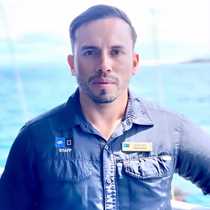Bartolomé & Santiago Island
Early in the morning we had a pre-breakfast outing to hike 365 wooden steps up to a light beacon situated at the highest peak on Bartolomé Island, a place known to many of us as an open book of geology.
After a dry landing we headed up the hill and encountered many parasitic scoria cones. This was like going back in time to the way the Galápagos were as the first islands were passing through the process of erosion.
As we hiked on the wooden steps, there were many pioneer plants growing by the sides of the trail. Most of them were very pale colors to retain more water and avoid the evapo-transpiration.
Very outstanding geological features were spotted and to some of us it was like walking on the moon but this time surrounded by parasitic cones, lava tubes, and a big blue ocean.
We made it to the top of the island and the end of the steps, being received by an amazing landscape. This was the beautiful picture of the North and South Beach with the famous Pinnacle Rock, the perfect look-out where we even got to see in the distance some of the other islands that we had visited before.
Later in the morning we went on a second adventure, but this time to explore the underwater world of Bartolomé. Landing on a white sand beach we had a walk over sand dunes and even explored the submarine wonders around Pinnacle Rock either on glass bottom boat or snorkeling.
We navigated to Santiago Island, also known as James , a very good place to find all sorts of geological features and learn a bit of human history of the Galápagos, since there were a couple of intents to colonize that island but never a long-term success.
Egas Port was the name of our visitor site on James Bay. The name itself (Egas) was the last name of a man that, during the 1920´s, established a salt mine, collecting sea salt from tide pools.
Along the hike many shore birds were spotted such as wimbrels, plovers, and oystercatchers. As always, charming us with their flips, the Galápagos sea lions were there as well.
At the end of the hike, when we thought we had seen it all, the landscape changed and in front of our eyes we had rusty lava grottos, which are actually collapsed lava tubes that connect with the ocean, creating a perfect habitat of vertical walls of lava and tide pools. In this place, we spotted Galápagos fur sea lions, a species limited in numbers and habitat because of being hunted during the 17th Century.
We finished another incredible day, knowing for sure that the islands have shared their most pristine secrets with us along this unforgettable week, and seeing the Galápagos as a pure example of natural richness.




